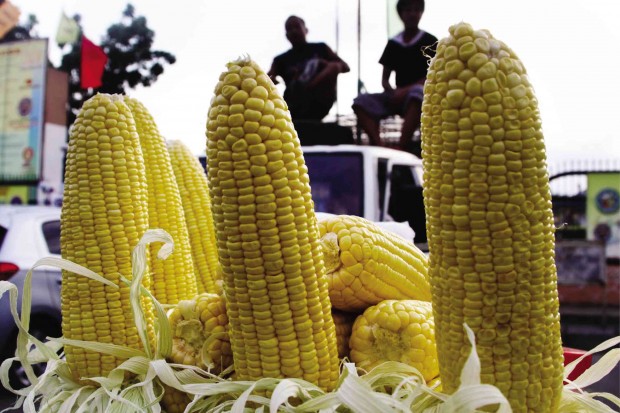Corn as staple food a matter of cultural taste

THESE corn cobs are ready to be grilled outside a market in Bayambang town in Pangasinan. The Institute of Plant Breeding at the University of the Philippines Los Baños promotes corn grits as part of Filipinos’ everyday diet. CHRIS QUINTANA/CONTRIBUTOR
NOW, this is when rice cooking becomes tricky. The Institute of Plant Breeding (IPB) at the University of the Philippines Los Baños (UPLB), with a program that champions corn as a Filipino staple, recommends mixing white corn grits with rice.
To achieve a perfect texture of softness and grittiness, the IPB recommends a 70-30 combination (70 percent rice, 30 percent corn) per meal, cooked following this water-grain proportion: for rice, 1:1, and for corn, 2:1, or two parts water and one part grain.
So cooking five cups of the rice-corn mix (three cups rice and two cups corn) requires seven cups of water, according to IPB experts.
This is not to complicate kitchen habits with a little arithmetic. In fact, the IPB team, led by Dr. Artemio Salazar, banks on simple, yet “cheap, accessible and sustainable” technology when it started the rice-corn blend program four years ago.
The IPB breeds Obatanpa, a variety of white corn from Africa. It is also called Quality Protein Maize (QPM), as it contains high levels of lysine and tryptophan, two essential amino acids that other corn varieties, or even rice, lack.
Article continues after this advertisementLong and slow
Article continues after this advertisementWith a specially designed mill that produces 100 kilograms of grits per hour, the IPB has sustained the production of QPM and sells them for P30 a kg. It supplies QPM to private hospitals in Los Baños, Laguna province, and in Makati City that serve the mix as part of meals served to patients.
In UPLB, Chancellor Fernando Sanchez in January issued a memorandum encouraging its concessionaires to serve the rice-QPM mix. UP president Alfredo Pascual, in December, gave away rice-QPM mix as holiday treats to university unit heads.
Despite these support, the program has yet to make an impact, with Salazar attributing this to Filipinos’ “cultural baggages.”
He acknowledges taking on a “long and slow crusade” to convince Filipinos and policymakers to shift from eating rice to corn.
Since corn is produced cheaper than rice, there is a general perception that “if you are a corn eater, you’re poor,” Salazar said. Worse, some people associate corn, especially the yellow variety, as animal feed.
In the Visayas and Mindanao, there may be some corn farmers who eat corn grits instead of rice, but even they would sometimes shift to eating rice when importation brings down rice prices.
Poor man’s food no more
“We want that [notion] erased,” Salazar said. “We want to promote [corn grits] not anymore from the perspective of just having enough food in the country but as a health food.”
Aside from QPM’s nutrient content, Salazar said corn is slowly digestible, thereby releasing glucose into the bloodstream slower than rice. This makes corn grits highly recommendable to diabetics who want to stabilize their blood sugar and to people who want to increase stamina.
The IPB, in 2014, also conducted a four-month test on 260 grade school pupils from a poor community here. The undernourished children served with rice-QPM mix showed a 20-percent weight gain.
The Philippines has 3.2 million hectares of land planted to rice and about 2.5 million ha to corn, Salazar said. A recent report from the US Department of Agriculture named the Philippines the world’s third largest rice importer as of 2016.
The country requires about 20 million tons of rice annually, of which 10 percent is imported.